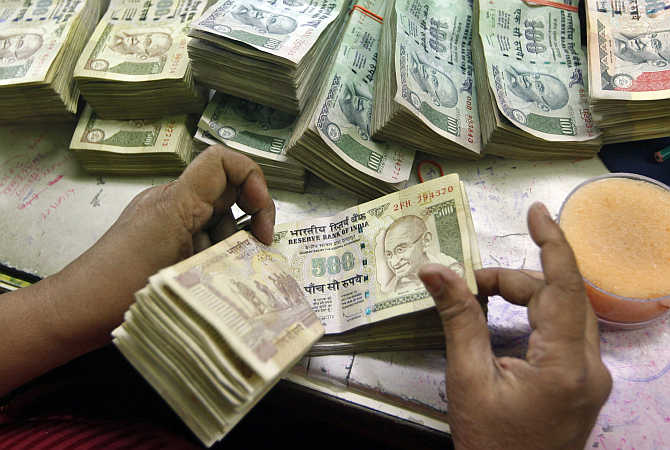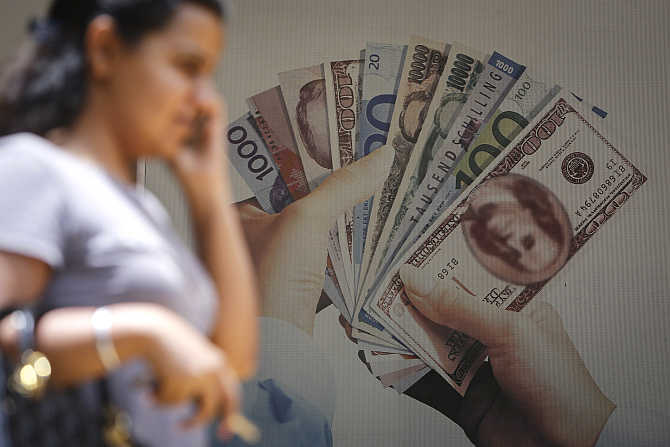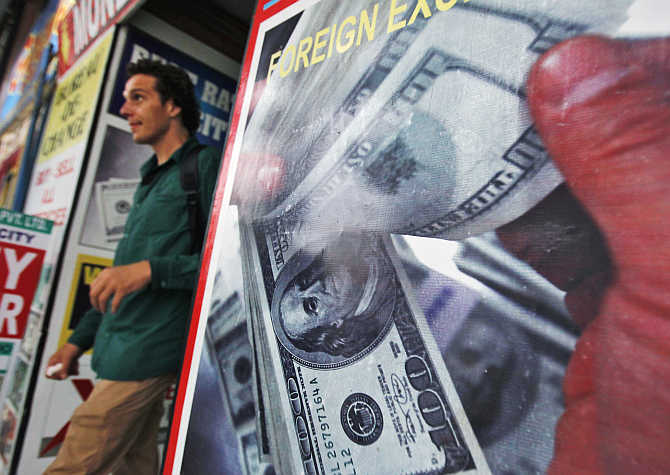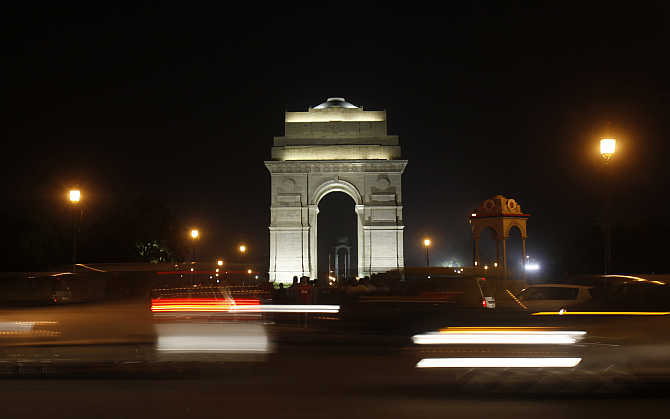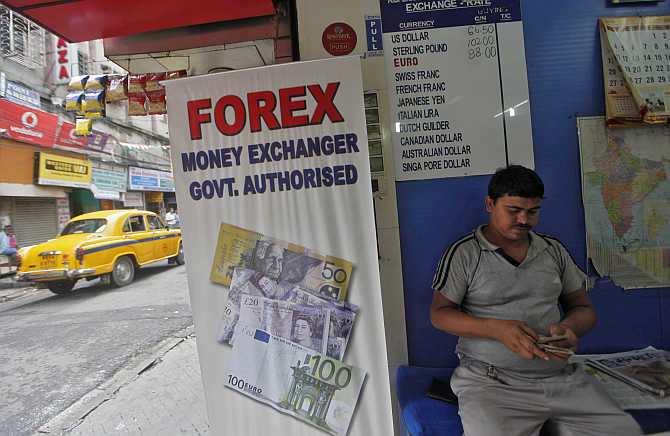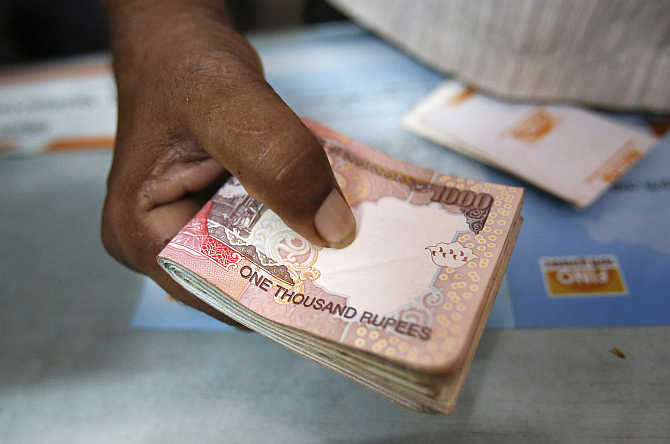 | « Back to article | Print this article |
'India needs Rs 2,000 crore a day of capital inflows'
Dr Ajay Shah, an aeronautical engineer (from IIT Bombay)-turned-economist, bottom, left, has been a trenchant critic of the defence of the rupee, saying it is causing more harm than good. At present with the National Institute of Public Finance and Policy, New Delhi, he says it is time to reform the RBI and the ministry of finance.
Excerpts from an interview with Amberish K Diwanji:
The rupee had fallen dramatically over the last few weeks. Any one particular reason that you’d say is the reason for this fall.
 India needs Rs 2,000 crore (Rs 20 billion) a day of capital inflows in order to finance the current account deficit. This capital inflow is largely a bet on India's bright future. When foreign investors saw the reversals of reforms on trade, capital controls, and financial development, their optimism about India declined. Now they needed a more depreciated exchange rate -- with the consequent possibility of a future currency appreciation -- to justify that same pace of capital inflows.
India needs Rs 2,000 crore (Rs 20 billion) a day of capital inflows in order to finance the current account deficit. This capital inflow is largely a bet on India's bright future. When foreign investors saw the reversals of reforms on trade, capital controls, and financial development, their optimism about India declined. Now they needed a more depreciated exchange rate -- with the consequent possibility of a future currency appreciation -- to justify that same pace of capital inflows.
Click NEXT to read more...
'India needs Rs 2,000 crore a day of capital inflows'
The RBI has tried to stem the fall, but in vain. Was the RBI right in seeking to defend the rupee or should we let market forces decide the rupee’s value?
I feel that our best strategy was to do nothing. The market determines the price of the rupee. If government tries to get involved in this, the distortions that arise are quite large and not worth the trouble. (Please see: Too sensational: The defence of the rupee, http://goo.gl/Iae99i).
There is also the problem of accountability. It is possible to hold the RBI accountable for a predictable inflation rate. It is possible to hold the RBI accountable for a fixed exchange rate.
But if we have a rate that fluctuates while RBI continues to do things to influence the rate, then it is impossible to construct an accountability mechanism. In a democracy, no agency should have power without accountability.
Click NEXT to read more...
'India needs Rs 2,000 crore a day of capital inflows'
Could the RBI have done anything to stem the fall? Will the recent move at tightening capital account help the rupee?
Tightening capital controls has made things worse. It has made foreign investors nervous about India's future. If a country lacks the policy making capability to make the right decisions when faced with such situations, then it has a less optimistic future.
Capital controls have also revived the worst instincts of Indian citizens, who are now keener to hold assets abroad, just in case the Indian State tries to interfere in their economic freedom in the future.
Thus, capital controls adversely affect the rupee through both impacts: the pessimism of foreigners and the pessimism of Indians. (Please see: Did the Indian capital controls work as a tool of macroeconomic policy, http://goo.gl/tMQxFY).
Click NEXT to read more...
'India needs Rs 2,000 crore a day of capital inflows'
Where do you see the rupee vis-a-vis the dollar at the end of the year?
I don't know. And nobody knows. It's a market. Just as we can't predict where Nifty will be on December 31, we can't predict where the rupee will be on December 31. (Please see: The rupee: frequently asked questions, http://goo.gl/XLHTSR).
Click NEXT to read more...
'India needs Rs 2,000 crore a day of capital inflows'
How will the rupee fall impact the economy? For example, petrol prices will go up, and this might push up inflation even as growth remains stagnant. Are we back to the “stagflation” days?
India has a long-standing failure on inflation. For a brief period of 1999 to 2006, we had price stability. Apart from this, we have failed. Delivering low and stable inflation is the first function of a central bank, and for the last 50 years we have failed on it.
A sharp rupee depreciation makes things worse. It is particularly painful because of the lack of anchoring of inflationary expectations. If we were a country where, ordinarily, people were comfortable that the RBI would deliver two per cent inflation, they would take some temporary price rises in their stride, and not confuse them with an acceleration of long-term inflation.
But in India, where the RBI has no credibility on achieving price stability, the surge in prices that will follow the depreciation will feed into the inflationary spiral.
Rupee depreciation hurts firms who had borrowed in dollars and left it unhedged. Finally, rupee depreciation is good news for exporters, for firms that compete with imported goods and for producers of things like steel, where the domestic price is the world price multiplied by the exchange rate. (Please see: The rupee: frequently asked questions, http://goo.gl/XLHTSR).
Click NEXT to read more...
'India needs Rs 2,000 crore a day of capital inflows'
What do you think should be done on a priority basis to stem the rupee’s fall?
The rupee is the thermometer. It is saying the patient has a fever. We should fix the patient and not the thermometer. All measures that directly target the rupee are thus wrong.
We should stick to the knitting on building India. Macro policy should deliver low deficits and low inflation. We must keep moving on fiscal, financial and monetary policy institution-building. We have a large and challenging agenda on reforms of the real sector.
Big projects that need to be pushed much faster are the Direct Tax Code, the Goods and Services Tax, Unique Identity Authority of India, the New Pension System and now the Indian Financial Code.
Click NEXT to read more...
'India needs Rs 2,000 crore a day of capital inflows'
Moving to the general economy, how much of the blame for the economic downturn can be blamed on external factors, and how much on the current government’s ineptitude?
The global environment is a difficult one. We should have slowed down to six to seven per cent GDP growth. Policy mistakes of recent years have, instead taken us down to four to five per cent GDP growth. When India was growing well, we kept putting off important reforms. Now we are seeing how valuable it would have been to fix the roof when the sun is shining.
Click NEXT to read more...
'India needs Rs 2,000 crore a day of capital inflows'
You have written that India needs to desperately reform its ministry of finance and the RBI. What in your opinion needs to be done?
Our ministry of finance and our RBI look most unlike the treasury or a central bank of global standards. We need to close this gap. Justice BN Srikrishna's 'Financial Sector Legislative Reforms Commission' has done fundamental rethinking of financial and monetary policy. (Please see https://macrofinance.nipfp.org.in/fslrc/).
The commission suggests that RBI should do monetary policy (with a clear objective and accountability on achieving it), and financial regulation for banking and payments. The commission also gives substantial new powers and autonomy to the RBI. All this, put together, will require considerable modifications in how the RBI works.
The MoF needs to be refashioned to become an engine of fiscal, financial and monetary institution building. In financial and monetary, the basic roadmap is that of the implementation of the draft Indian Financial Code drafted by Justice Srikrishna Commission. The seven-agency architecture suggested by this commission needs to be analysed from an MoF point of view: What are all the roles and responsibilities required of MoF in that world?
In the field of fiscal institution-building, we need to establish a sound foundation of tax policy and tax administration, start financing public borrowing in a non-coercive way, set up sound systems for budgeting, accounting and accountability of all government departments.
Click NEXT to read more...
'India needs Rs 2,000 crore a day of capital inflows'
Finally, India tends to do best when in a crisis. Do you see a light at the end of this tunnel? When is that due?
I am more optimistic than most about India's possibilities. In the 1970s, it was possible to sink into socialism and never escape from it. Now, we have unleashed new forces of accountability. When the government passes the Food Security Bill, Nifty and the rupee crash. Quarterly release of GDP data constantly kicks the government towards more sanity. With a large current account deficit, we are accountable to foreign investors.
All this adds up an environment of much more scrutiny, negative feedback for mistakes, and positive feedback for doing the right things. When we make mistakes -- like the defence of the rupee -- we get slapped and rapidly fall in line.
This is a wonderful new world, where economic policy formulation faces accountability mechanisms, compared with the sustained mediocrity of India's bad period (from 1962 to 1979).

